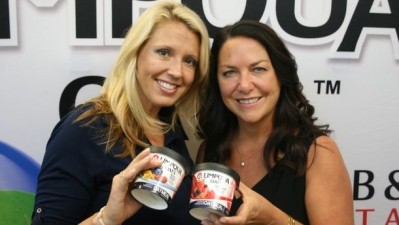Dr Richardson: 'Strategic plans empower entrepreneurs to say ‘no’ to the wrong opportunities'
GUEST ARTICLE: Why entrepreneurs need a strategic plan

Would you climb a 14,000ft mountain without vetting your route and without making sure you had the right supplies and physical training? Would you go on a 200-mile bike ride without planning your route, bringing spare tubes, and knowing how much food and water to bring?
These are easy examples of activities where the need for advanced planning is blindingly obvious even to novices, precisely because the activity is intuitively beyond our capabilities. Even those who don’t know what these plans should contain know a plan is a must.
When we clearly know we aren’t good at something, it’s easy to understand the need for planning, training, preparing. Really easy. But coming to this self-awareness is not so easy for new food and beverage entrepreneurs. In fact, it’s actually pretty difficult.
Why?
1. The first 100 customers aren't your business
In food and beverage, there is a cognitive trap for young entrepreneurs that is much stickier than for founders in many other industries. Food and beverage entrepreneurs can make and serve their creation in a home kitchen and serve it up like a sacred, home-made creation to friends, family, and co-workers in an emotionally charged, intimate social context (where the ‘truth’ is hard to find).
Although you may have slaved over the recipe for months, even years, it takes very little time to create a positive social feedback loop on your passion. I’m not trying to point out the truism that friends and family are too invested in flattering your creation to give you honest feedback. I’m trying to point out that it doesn’t even take a single retail sale to create a positive feedback loop between real people and your passion.
In other words, you can literally feed your new product to hundreds of non-customers without much effort or expense. But these folks aren’t part of your business. They’re just fans. Even if they paid you, which they probably didn’t.
Although your creation is probably the single most determining variable in your long-term success, it represents at most 10% of the absolute sweat effort to win.
2. Amazon is a launchpad... and a strategic crutch
One of the best things that has happened to shelf-stable food entrepreneurs in the past century is the Amazon e-commerce platform. Tens of millions of Prime shoppers who pay nothing for shipping? Wow. If only the old Sears catalogue had thought of that.
What could be a better environment to spread the love around your new food or beverage product with better margins than brick-and-mortar retail and much, much less risk of over-production/buybacks?
Amazon is a retailing version of LinkedIn, allowing you to expand your ‘circle of product fans’ a few degrees beyond what normal, face-to-face social life could ever yield you.
But it is far too easy a retailing platform to represent anything close to an actual, real world food or beverage business.
For entrepreneurs with a truly innovative offering in their respective category, Amazon can create wonderful growth without doing much of anything other than shipping and logging on to Seller-Central. That’s because Amazon began as a ‘specialty’ channel where consumers are used to hunting and exploring and doing all the work of finding cool stuff they can’t find offline.
But, this only makes Amazon even more likely to be a crutch for new and innovative entrepreneurs secretly terrified by planning for the complexities of brick and mortar distribution.
If growth is happening on its own, why not just ride it to glory?
If your financial goals are humble, I can’t really disagree. But, if this doesn’t sound like you, please keep reading…
3. Competition to get on real shelves is intense
In the world of premium food and beverage, where most of you compete, the entire retail ecosystem from Whole Foods to Walmart is prioritizing your class of goods right now because it’s where almost all of the top-line growth is happening. The willingness of retailers to cut back on facings of legacy processed brands to make room for you might seem to make things easier for you.
Actually, it’s quite the opposite. Because retailers are intently focused on on-boarding premium brands, you are now in a very crowded ‘boarding gate’ in almost every value-added food and beverage category.
If you were a retail buyer, flooded with inquiries by premium entrepreneurs, to whom would you give preference after a meeting?
The company who came in and talked a lot about their product, SRP and unit margins but didn’t seem to have a clear vision of where they were going, let alone what they could offer you in terms supporting services to drive sales? Or the company who had a five-year strategic plan which featured you at the core of a careful, national expansion with carefully thought out banners and locations (per the brand’s most predisposed consumer target) and a smart trade/consumer marketing plan?
The organized, visionary and ambitious always win out over the passionate, well-intentioned but drifting.
4. Without a plan, distributors and brokers treat you differently
The harsh reality of the food business is that brokers and distributors are happy to take the business of entrepreneurs who have a differentiated product they are pretty sure will grow almost on its own.
This doesn’t harsh. It sounds awesome, right? Well, only until you poke under the surface of their ‘agreement’ to sell your product.
Brokers and distributors have access to dozens and dozens of case studies, many on their own books, where young, differentiated brands with no marketing and limited trade activity, experienced steady, geometric growth due to the structural power of a premium positioning in American food retail. It’s as close to automatic growth as one can get….so, they easily work with brands like these…and then a better organized 2nd mover comes in.
And then you will experience the harsh reality of the food and beverage business. Your broker/distributor who treated you OK up until then will suddenly start giving preferred shelving and service to your competitor.
Why?
It’s tempting to blame it on the ‘luck’ of better funding. But you may be surprised to learn that people who get professional sources of funding generally get it because they convinced someone they have a plan. The plan may not be a crystal ball, but it indicates that the owner is serious about certain revenue targets and knows how to get there.
Retailers and distributors are more likely to believe a company’s promise to generate accelerated profits for everyone in the value chain, if they can see the plan to get there. Nobody invests very much in hope alone.
Sure, you’ve generated profits for your broker/distributor until now, but the new guy will easily reproduce the profit volume you’ve generated and more. In other words, your broker/distributor can now literally afford to lose your business in the future and move on. That’s harsh.
5. Strategic plans empower you to say ‘No’
My favorite clients are the ones who initially tell me they already have a plan. Sorry James, no dice. Yes, it’s bad news for my near-term business…but I appreciate folks who are organized and serious enough to already be following a strategic plan, especially when their business is below $1million in revenues.
It’s pretty rare for food and beverage companies that small to be following a plan, although most serial entrepreneurs operate this way.
One of the lesser discussed benefits of a strategic plan is that, when the external environment catches wind of you (after a trade show, magazine article, LinkedIn post, etc.), you will start to get more and more e-mails. Serial entrepreneurs will tell you that the most dangerous e-mails are the ones that get you the most excited: the ones from retailers.
Is this the right retailer for your brand and offering? Is now the right time for this retailer? Can you even service them? Do you understand the retailer’s corporate strategy and where you fit in?
With a strategic plan, this retailer is already included/excluded along an optimal timeline for development of a healthy business. Optimal for you, not the retailer who just emailed you. The plan reminds of you why and how you want to enter that retailer, or class of trade…and when. This allows you to quickly respond and move on. If it’s perfect timing, that’s awesome. But, often, it just isn’t.
The take home:
• Don’t confuse proof-of-concept as a food or beverage (distributing to enthusiastic friends and family) with proof-of-concept as a viable business.
• Strategic plans enhance trust-building with your broker, distributors and retail buyers.
• Strategic plans empower you to say ‘no’ to the wrong opportunities
James F. Richardson, Ph.D. – formerly senior VP of knowledge and innovation at Hartman Group - is a growth strategist for emerging food and beverage brands and founder of Premium Growth Solutions, a new consultancy for entrepreneurs and investment firms focused on the premium end of retail food and beverage.










